- Home
- The Moon
the moon
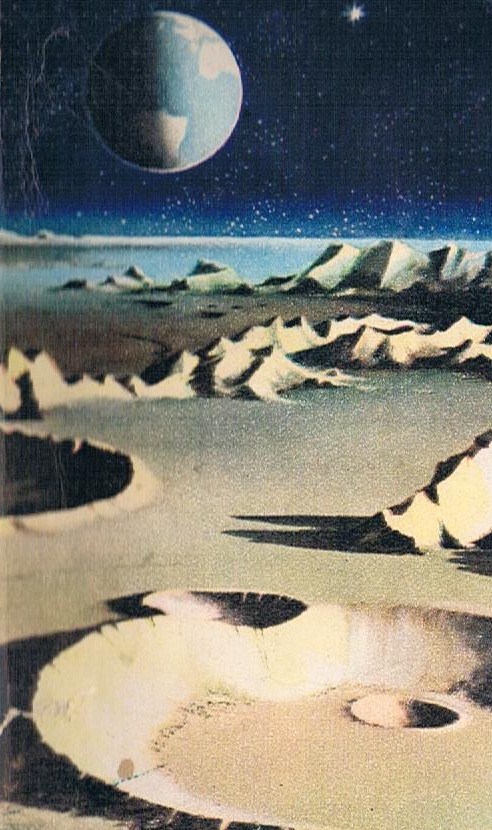
[+ links to: A Harsh Beauty - the unforgiving moon - Ancient Inhabited Moon - Archives of the Moon - Earthlight - The First Men in the Moon - The Great Moon Hoax - Implicizer on Blowups Happen - Land Rush, King Rush, Moon Rush: R H Romans' Lunar Epic of 1930 - Lovecraft's Moon -
Lunar Surface Creatures - Lurkers on the Moon - Man to Mars and Moon -
The Mare Frigoris Culture - Moon Quiz - Thoughts on the Earthlight Article -
What to see on the Moon ]
the one and only moon
A dead world? Depends which story you read. Quite a few science fiction writers imagine lunar life. Others stick to a realistic, lifeless or near-lifeless Moon. And you could say there's a third category, borderline... of which more later.
But they all have this in common: that our Moon is the one and only Moon with a capital M; the silver gleam of mystery in our nights, an unattainable jewel of a world.
Stid: 'Unattainable'? You sound like an Apollo-basher. Are you literally trying to say that the Moon has not been reached? That the flights were faked?
Zendexor: Of course not. But it will take more than six brief expeditions to make the place familiar to us. For that matter, what is intimately familiar can also be utterly mysterious - ask anyone who's married. 'Unattainable' refers, here, to its essence. Its inner mystery.
Stid: In that case, what you're saying could also be applied to the Earth.
Zendexor: It could, but this page is about the Moon, and here I must insist, there's nothing like the Moon. It has, you might say, Cosmic Heritage Status. Definitely a world - with all the uniqueness that implies.
Stid: Well, all right. It's a world, yeah. Don't suppose you'll find anyone to deny that.
lunar integrity and native lunar life
Zendexor: Not directly deny it, no. But there used to be a theory - now discarded, thank goodness - that the Moon was merely a piece that broke off the early Earth. Just a piece of Earth - what a let-down!
And this assumption about lunar origins was expressed in many tales of lunar exploration, from the children's yarn Dr Dolittle in the Moon to the Golden Age classic The Moon Era.
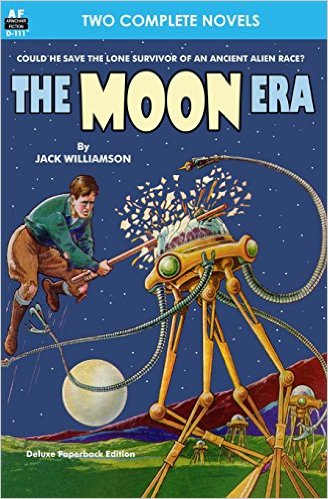
Harlei: You feel, then, that the Moon was somehow demeaned by being thought of as a piece broken off the Earth... but I'm not so sure. Look at it this way. You could regard both the Moon and the Earth as originally forming part of a bigger world - call it 'Mearth'. In which case, it's not just a case of one being a piece of the other...
Zendexor: I like that face-saving idea, and yes, I use it to help preserve my enjoyment of The Moon Era, which, let me tell you, is one heck of a masterpiece. It's a time-travel tale, to a distant past when the Moon was young and inhabited. I don't know of any other major young-Moon tale to match and compare it with. (Click here for more on the ancient inhabited Moon.)
The two other main inhabited-Moon stories that I know of - The First Men in the Moon and The Moon Maid - do not involve time travel. Their narrators explore a contemporary living Moon. In their very different ways, they are great yarns.
Stid: It is odd to hear you mentioning Wells' masterpiece and Burroughs' romp in the same breath. You almost might as well bring in Dr Dolittle in the Moon and its talking vegetables and moon-cats... not to mention Otho Bludge, the Stone Age man marooned on the moon when the latter broke off from the Earth, which must have happened somewhat more recently than theory allowed...
Zendexor: I don't apologize for comparing The First Men in the Moon with The Moon Maid, bizarre though the match may seem. Of course Burroughs wasn't an intellectual like Wells -
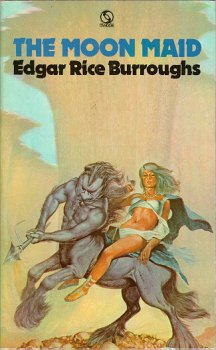
Stid: He sure wasn't. Lunar craters as holes leading into a hollow Moon! Human Selenites living inside! Anything to hang a story on.
Zendexor: Hmm... actually, one could argue that Burroughs' hollow Moon, as an abode of life, though impossible, does not contradict our visual observations as flagrantly as do Wells' blithe descriptions of luxuriant vegetation sprouting on the surface.
As for the humans inhabiting Burroughs' Moon - contrasted with the insectoid Selenites of Wells' - you just have to accept the Burroughs convention, that life everywhere tends to evolve towards the human form. Give him his due, he does also give us alien intelligences co-existing with them.
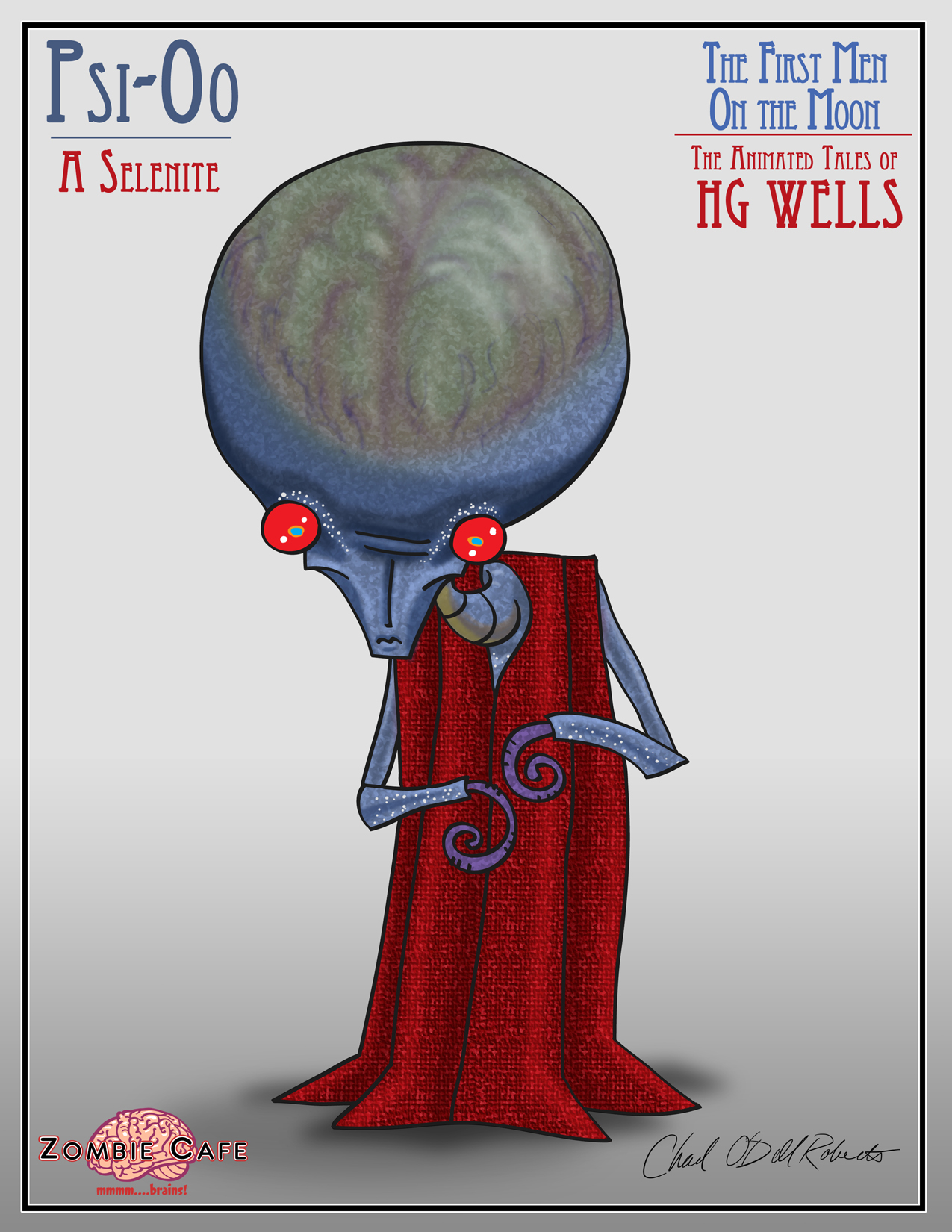
Not as impressive as Wells' Selenites, of course. Cavor's messages from the lunar depths, and his encounter with the "Grand Lunar", are profound in every sense of the word. The First Men in the Moon develops the lunar-life theme to a greater extent than does any other novel.
What I really long for, however, is for someone to write a great novel about a native civilization on the surface of the Moon.
Harlei: Magician of Dream Valley...
Zendexor: That's not a novel -
Harlei: I was just thinking aloud. Let me finish. The Hexagon Lights are a fascinating, etheric form of lunar life, hovering around over the lunar surface... an intelligent species, endangered by radiation given off by human installations, and capable of dangerous resistance. As you say, Zendexor, it's not a novel, but it's something.
living lunar energy
Zendexor: All right, but can we be sure that energy beings like the Hexagon Lights really are, in any meaningful sense, natives of the Moon? Can such creatures really belong to the world they haunt? Or are they more like the interplanetary eldila in Lewis' Cosmic Trilogy, or the flame beings in Sunfire! or the thing in Child of the Sun - creatures which appear on Mercury and Vulcan respectively, without really belonging to either of those worlds?
Harlei: I agree that in the examples you give the energy beings are solar rather than planetary. But in Magician of Dream Valley the Hexagon Lights really are Lunarians. Here is a passage that contains my documentary proof (watch for the phrase I have put into italics):
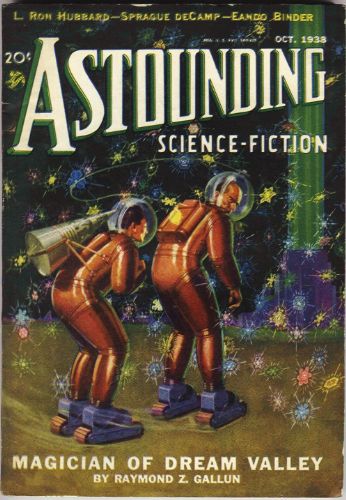
Dream Valley! Hexagon Lights! Composed only of a soft, auroral luminescence as far as anyone could see, they altered their shapes and colors constantly. Now they were simple, diaphanous planes of a six-sided form. And now they took on all the beauty and geometric complexity of a snowflake expanded to colossal size.
Yet they were, according to accepted scientific opinion, no more than phenomena related to terrestrial auroras, being induced in the minute trace of Lunar atmosphere by incoming electromagnetic waves from the Sun. Some odd, natural condition, peculiar to the Moon [my italics], was supposed to give them their crystalline shapes by reflecting in some manner, and in enormously magnified size, the forms of minute ice crystals still floating in what little remained of the Lunar shell of air...
Zendexor: All right, Harlei, you've made your point - Magician of Dream Valley is a proper tale of lunar life, worth pointing out, worth reading.
To return to my theme, now: my yen is for a novel that portrays a material civilization of corporeal lunar natives. It would have to be set in the past, I suppose. Like The Moon Era - but of novel length. And it would portray a culture in its prime, instead of The Moon Era's lone survivor.
A full-focus portrait of a young and living Moon, that's what I'd really like. Get going, retro writers! Do for the Moon what Valeddom did for Mercury - and I'll rush to order it before you can say "Selenite".
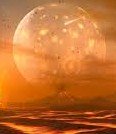 Primordial Moon - Mark Garlick
Primordial Moon - Mark GarlickStid: Don't look at me, Zendexor; I prefer to read what's been written already, and appreciate it on its own terms. There are volumes and volumes of good stuff set on the Moon.
Zendexor: And in that forest of writing lies the trail to what I want. Now to follow that trail.
Because it's a hints-trail, it is full of casual throw-away references, many of which are in stories which are hardly concerned with the Moon, yet still worth noting in our quest.
Stid: Give the Quest a title. Just to remind us what we're doing.
Zendexor: I was going to call it 'Lunar Life', but that's misleading. True, the thought of organic lunarian life fascinates me, but I'm not rejecting the so-called 'dead' Moon either -
Stid: You're easy to please, Zendexor: I give you that. I thought you were going all out to rummage for a lunar civilization -
Zendexor: What you mean is, if I'm happy to read about a Moon with or without life, what exactly is the point of my quest?
Harlei: Stid, he means -
Zendexor: Shh, let him find out. Follow me obediently, both of you, and learn The Secret of the Moon.
a moonlit trail
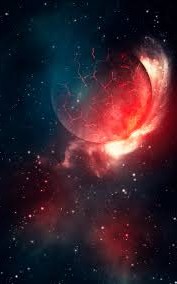
A strange story called Beyond Pluto glancingly mentions an ancient race of Lunarian humans, the result of convergent evolution due to the Moon having "the same chemical composition as Earth". Disappointingly, it's just a mention.
More interestingly, in Blowups Happen it also transpires that there was a lunar civilization. This one destroyed itself with nuclear explosions, and the craters of the Moon are the result of those explosions - as is the lack of a lunar atmosphere.
It's another glancing mention, another mere scrap, but it packs more of a punch than the one in Beyond Pluto. For one thing, Blowups Happen was written by a major sf author, one of the very greatest. The story has a most technical and realistic feel to it. And hauntingly, the lunar wipe-out it refers to was so total that there's no hint as to what the lunarians may have been like. The only proof of their existence lies in measurements of the craters, which mathematically reveal their disastrous artificial origin. (What one wouldn't give for a time-viewer like that in The Dead Past, but attunable to fictional worlds!)
Moon-dwellers in suspended animation actually do appear, and wake up for one last time, in The Last Lunarians, a tremendously disappointing story. A priceless relic - the remnant of an ancient Moon-race - offers a bit of menace and gets immediately slapped down, and that's that: no awe, no curiosity, no follow-up of this colossal discovery.
Here again I shall pair up two tales to find, paradoxically, that where less is said, more is given. Compare the fiasco of The Last Lunarians with the much briefer mention in That Hideous Strength.
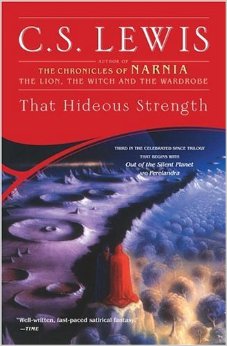
In the latter novel, by means of a few scattered references the reader is told of the divided Moon. In conversation in Latin, with a seer from our Dark Ages:
"Sulva is she whom mortals call the Moon... Half of her orb is turned towards us and shares our curse. Her other half looks to Deep Heaven; happy would he be who could cross that frontier and see the fields on her farther side..."
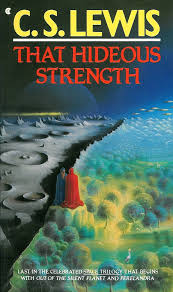
Whereas the enemy sees it differently.
"There
are still surface-dwellers - savages. One great dirty patch on the far
side of her where there is still water and air and forests - yes, and
germs and death."
The antiseptic immortals on the sterile near-side, in their aim to exterminate the organic far-side people,
"are slowly spreading their hygiene over their whole globe. Disinfecting her. The savages fight against them. There are frontiers, and fierce wars, in the caves and galleries down below. But the great race press on. If you could see the other side you would see year by year the clean rock - like this side of the moon - encroaching: the organic stain, all the green and blue and mist, growing smaller. Like cleaning tarnished silver."
Stid: A fascinating scenario, but it wouldn't work. The Moon doesn't have the gravity to hold an atmosphere, and even if it did, you couldn't have a world with an atmosphere on one side and none on the other -
Harlei: Ah, shut up, Stid. If it works poetically, that ought to be good enough for any reader.
Zendexor: Indeed, scientific principles, while still of some importance, are somewhat laxer in the Old Solar System, allowing more suspension of disbelief - so yeah, shut up, Stid.
And back to the point which is that The Last Lunarians, though it takes us to the Moon and shows us the Moon people, gives us nothing much, whereas That Hideous Strength, set entirely on Earth, gives us an unbeatable Moon in a few lines.
Harlei: "Less is more"?
Zendexor: Looks like it often is, but of course I'm not satisfied - I want to arrive rather than travel hopefully!
The extreme case of tantalization occurs in A Voyage to Sfanamoë.
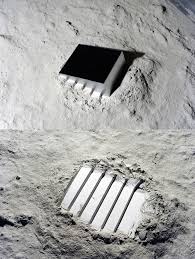 lunar archives uncovered
lunar archives uncoveredHere are its opening two sentences. I've put the tantalization in red.
There are many marvellous tales, untold, unwritten, never to be recorded or remembered, lost beyond all divining and all imagining, that sleep in the double silence of far-recessive time and space. The chronicles of Saturn, the archives of the moon in its prime, the legends of Antillia and Moaria - these are full of an unsurmised or forgotten wonder.
And that's it - never elsewhere in all his stories does Clark Ashton Smith give us the slightest further nibble at that lunar bait. (Though at least we do have, on this site, an attempt to fulfil the promise of The Archives of the Moon.)
Harlei: Wait, I've got something else for you here - listen to this - it's from Ascharia - the Lemurian space-voyager speaking:
In the years preceding the submersion of Mu, this tale was told to his children's children by Hespire the space-wanderer, when he had grown too old for the fatigues and rigors of ultra-mundane voyaging:
During my numerous trips to the inner and outer planets (said Hespire) I saw such marvels and met such adventures as would make the wildest legends of the world's youth appear credible by comparison. Some day, perhaps, I will tell you of my encounter with the frightful but insubstantial giants who infest the hidden side of the moon...
Zendexor: All right, thanks, Harlei, I had forgotten that one extra little fragment. But that's all Ascharia is - a synopsis and fragment, of a tale Smith envisaged but never got down to write. I really am getting impatient with scraps. Time to lurch to the other extreme. Grab a novel. An honest-to-goodness novel completely set on the Moon. And a good yarn - one of the best - one which I have read innumerable times. But... realistic.
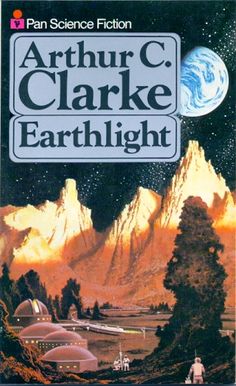
Stid: Realistic, eh - oh dear, that means goodbye to native lunar life, and, instead, picking a novel about the colonization of the Moon.
Zendexor: It does have lunar cacti, actually. To quote from chapter 5 of Earthlight:
Perhaps the most astonishing discovery of the first explorers was the existence of plant life. It had long been suspected, from the peculiar changes of light and shade in such craters as Aristarchus and Eratosthenes, that there was some form of vegetation on the Moon, but it was difficult to see how it could survive under such extreme conditions. Perhaps, it was surmised, a few primitive lichens or mosses might exist...
The guess was quite wrong. A little thought would have shown that any lunar plants would not be primitive, but would be highly specialised - extremely sophisticated, in fact, so that they could cope with their hostile environment...
The unique feature of the lunar plants... was their ingenious mechanism for collecting air. An elaborate system of flaps and valves... The plants were patient; they would wait for years along the great crevasses which occasionally gush forth feeble clouds of carbon or sulphur dioxide from the Moon's interior. Then the flaps would go frantically to work, and the strange plants would suck into their pores every molecule that drifted by, before the transient lunar mist dispersed into the hungry near-vacuum which was all the atmosphere remaining to the Moon.
No matter how far the excitement of realism differs from the excitement of daydreams, Clarke is amazingly good at coating his realism with a dream-glow. (So much so that our website has a special page devoted to Earthlight.)
Now, subtract the cacti, and you have a completely inorganic Moon, a lifeless Moon - or could there be such a thing as inorganic life? The frozen intelligences in The Mind Parasites, perhaps; or the substance "marlionum" in Shoot at the Moon.
A confession: the first time I read Shoot at the Moon, I had the impression that "marlionum" was alive, and malevolent; the second time I read the book, many years later, I was left with the opinion that the stuff was merely a very dangerous natural substance. I hold that ambiguity to be a compliment to the book. It's the "borderline" case I mentioned at the top of this page.
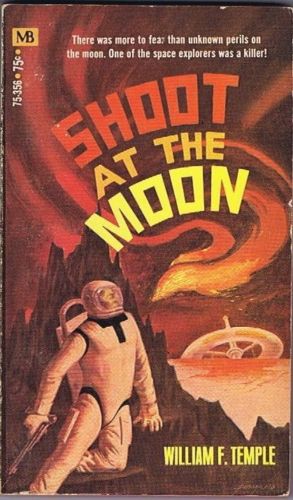
Harlei: Take it from me, the stuff's alive - albeit primitively. It's the substance of the Tycho rays -
Zendexor: You mean, the actual ejecta rays, the splashes from the ancient Tycho crater impact?
Harlei: I've read the book more recently than you, evidently! Yes, I'm referring to the ejecta rays, except that in the story there must be more to them than that. The explorers who first come across the stuff - during a search for gold - don't realize that what they have found is alive in some electrical/mineral sense. Alive and dangerous.
I drove on. Presently I saw, stretched along the horizon ahead, a bright line under the earthlight. The Tycho streak.
As we neared it, the effect became spectacular. We were coming upon the bank of a frozen river of metal so wide that we couldn't see the other side. It appeared so effulgent to my eyes - accustomed to the dull rock bed - that I was forced to shade them for a while.
When the explorers get out of their vehicle and examine this "river of metal", it turns out to consist of peelable diamond-shaped sheets.
...It was difficult to assess the texture of the stuff as it hung in the resistless void from one's stiff, encased fingers, but I got the impression that it was as floppy as wet cardboard...
Misleadingly inert. But soon the narrator's companion glimpses something moving up in the sky.
I turned quickly and stared at the star-sprinkled sky to my left. Something up there flashed briefly, like the wing of a banking airplane momentarily catching the sunlight...
I reckon this story successfully builds up more suspense and excitement than if it had dealt with organic life.
Zendexor: As I remember it, its mood is appropriate for our transition from life to the last part of our moon-trail which finally leads us to what you might call (misleadingly, though) the dead end of non-life.
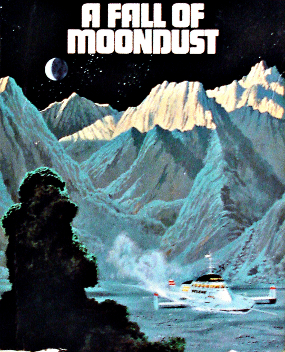
No doubt is left in the mind of the reader of A Fall of Moondust, that the setting of the novel is a dead version of the Moon. And yet it's a great story, its setting just as fascinating as the cactus-harbouring Moon of Earthlight.
What is going on here? Subtraction after subtraction, and yet we're left with as much as before.
What's happened, is that we've found what we were looking for.
The secret of the Moon -
Life isn't the only alternative to Death. There is also a positive thing that is not death even if it is not "life". The "dead" Moon has it.
As for what to call it -
Ann Clayborne, the zealous anti-terraformer who wanted Mars kept pristine, never could explain it, though she kept trying, throughout Red Mars, Green Mars and Blue Mars.
Something that isn't life but is as valuable as life or even, one has to say, as alive as life though devoid of organic matter.
So - call it Aliveness.
Or just Quality, or mineral "character" - such as that of the remarkable objects in The Singing Bell, the tale in which Asimov gives us a distinctive lunar natural artifact, as memorable as the Sea of Thirst in Clarke's A Fall of Moondust.
With surprising delicacy, his pudgy fingers maneuvered the Bell, feeling for one best spot. He adjusted it, steadying it daintily. Then, letting the Bell swing free, he brought down the thick end of the bone spoon and stroked the Bell softly.
It was as though a million harps had sounded a mile away. It swelled and faded and returned. It came from no particular direction. It sounded inside the head, incredibly sweet and pathetic and tremulous all at once.
It died away lingeringly and both men were silent for a full minute.
Dr. Urth said, "Not bad, eh?" and with a flick of his hand set the Bell to swinging on its wire.
Davenport stirred restlessly. "Careful! Don't break it." The fragility of a good Singing Bell was proverbial.
Dr. Urth said, "Geologists say the Bells are only pressure-hardened pumice, enclosing a vacuum in which small beads of rock rattle freely. That's what they say. But if that's all it is, why can't we reproduce one? Now a flawless Bell would make this one sound like a child's harmonica."
Stid: All very well, but all you're saying - and I admit it's worth pointing out - is that Asimov and Clarke, are great enough hard-science-fiction authors, that their stuff wraps emotion round its "hardness", making it of interest to us human softies. To use psychological language: it's a cathexis. This is especially true of Clarke.
But with regard to his modern and realistic view of the Moon - what's it doing on our website which is supposed to be devoted to the Old Solar System?
Zendexor: For an answer to that - see the Earthlight page.
Isaac Asimov, "The Singing Bell" (The Magazine of Fantasy and Science Fiction, January 1955); "The Dead Past" (Astounding Science Fiction, April 1956); Leigh Brackett, "Child of the Sun" (Planet Stories, Spring 1942); Edgar Rice Burroughs, The Moon Maid (1923); John Scott Campbell, "Beyond Pluto" (Fantastic Story Quarterly, Fall 1951); Arthur C Clarke, Earthlight (1955), A Fall of Moondust (1961); Raymond Z Gallun, "Magician of Dream Valley" (Astounding Science Fiction, October 1938); Robert Gibson, Valeddom - Mercury Awaits (2013); Edmond Hamilton, "Sunfire!" (Amazing Stories, September 1962); John Beynon Harris, "The Last Lunarians" (Wonder Stories, April 1934); Robert A Heinlein, "Blowups Happen" (Astounding Science Fiction, 1940); C S Lewis, That Hideous Strength (1945); Hugh Lofting, Dr Dolittle in the Moon (1928); Kim Stanley Robinson, Red Mars (1993), Green Mars (1994), Blue Mars (1996); Clark Ashton Smith, "A Voyage to Sfanomoë" (Weird Tales, August 1931); "Ascharia", from Strange Shadows: The Uncollected Fiction and Essays of Clark Ashton Smith, Ed. Steve Behrends, Donald Sidney-Fryer and Rah Hoffman, 1989); William F Temple, Shoot at the Moon (1966); H G Wells, The First Men in the Moon (1901); Jack Williamson, "The Moon Era" (Wonder Stories, February 1932); Colin Wilson, The Mind Parasites (1967)
For the survival of the Otherness of the pre-Apollo un-attained Moon:
see the OSS Diary, 2nd August 2016.
See the OSS Diary, 17th September 2016 for Mercury, the Moon and the Old Space Program.
For nineteenth-century ideas regarding native lunar life, put forward by Franz von Gruithuisen, see the OSS Diary for 14th November 2016. For more nineteenth-century ideas which could be linked to C S Lewis' fertile and inhabited Lunar Farside, see the OSS Diary for 17th November 2016.
For stories of sinister selenological phenomena see Lurkers on the Moon.
For a future Moon with a thin atmosphere see the OSS Diary for 17th December 2016.
For a much further-future "greened" Moon see the answer to Moon Quiz excerpt 3.
See also Giving the Moon an atmosphere.
For comments on The Moon People by Stanton A Coblenz, see the OSS Diary for 17th January 2017.
For more on Shoot At The Moon, see the OSS Diary, 20th January 2017.
For the intellectual class among Wells' Selenites see the OSS Diary, 30th January 2017.
For an AI mystery at a British lunar installation, see the OSS Diary for 10th February 2017, discussing Moon Base (1964) by E C Tubb.
For A Fall of Moondust by Arthur C Clarke, see the OSS Diary, 16th February 2017.
For a link between lunar and solar life, see the OSS Diary, 23rd February 2017, on
Colin Wilson's The Mind Parasites.
For HPL and the Moon in The Dream Quest of Unknown Kadath, see Lovecraft's Moon.
For The Lunar Pit and other reflections see Poor Deadly Moonmen.
For the children's tale, Dr Dolittle In the Moon, see the Diary, The Torn-Off Moon.
For Simak's The Trouble With Tycho see A Harsh Beauty - the Unforgiving Moon; also the Diary, Simak on the Moon.
Yearning for the Moon is discussed in the Diary, Cathexis in C S Lewis and Heinlein.
For gradients on the Moon see the Diary, Verticality.
For what might happen to our satellite during the next three billion years see the Diary,
Poul Anderson and a Far-Future Moon.
For how one might use the lunar events of 1178 and 1958 in a story, see the Diary,
Ghostly Twitches from the OSS.
For an other-dimensional counterpart to Luna see Ul Quorn Back from the Dead.
The Diary entry, Hugh Walters on the Moon, offers thoughts on the first four juveniles in the Chris Godfrey series of novels.
For thoughts about Urey's theory of the lunar maria, see Watery Lunar Seas.
For the last gasp of Farside-life ideas see The Hidden Side of the Moon - 1949 - 1959.
For communications as hindrance or as aid to creating a mood, as exemplified in two contrasting Moon tales, see Telemetry-bane.
For more on the craters-mystery as set out in Blowups Happen, see
De-Luxe Science-Patter.
For Charles Babbage's nineteenth-century opinion on craters see Atolls in the Lunar Seas.
For nineteenth-century ideas on signalling visually to Lunarians, see Communication with the Moon.
For a comparison between an old and a modern lunar landscape, see Rugged versus un-rugged Mount Pico.
For running water on the terminator see A nineteenth-century quarry of story-ideas.
I criticise Arthur C Clarke's views on lunar names in Clarke mistargets the Lake of Death.
Borderline settings is a discussion which touches upon a habitable lunar niche.
For the idea of pre-Lunarian moons see Welteislehre and creative crankery.
See also the Moon Quiz and CLUFFs. And see the Gazetteer, passim.
For a good site for a lunar base see Mare Smythii.










































